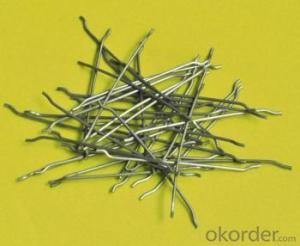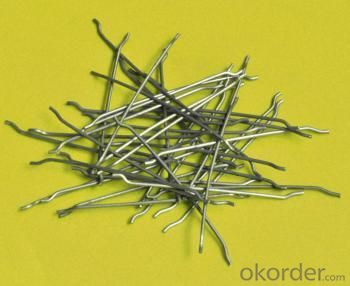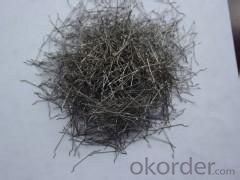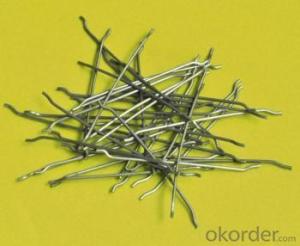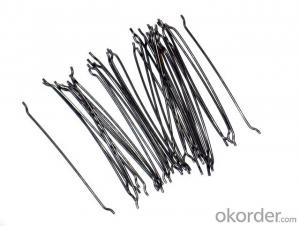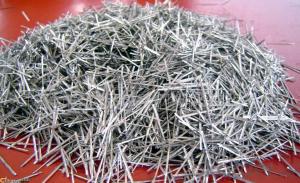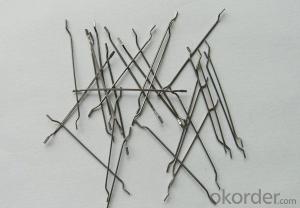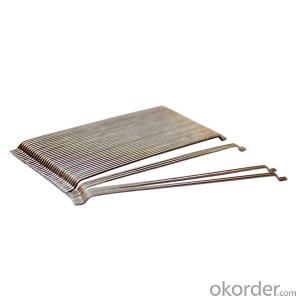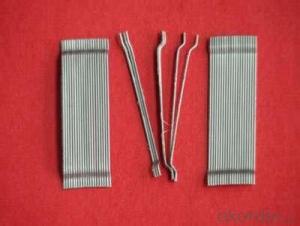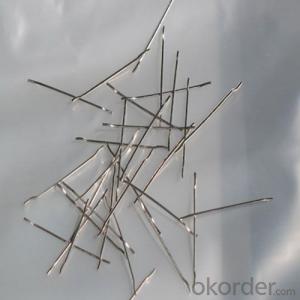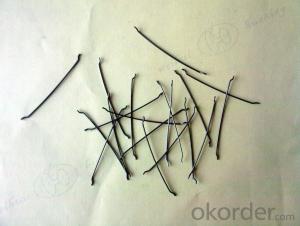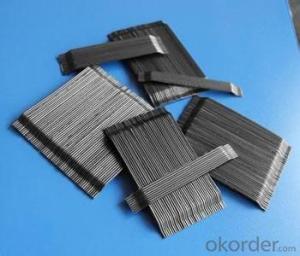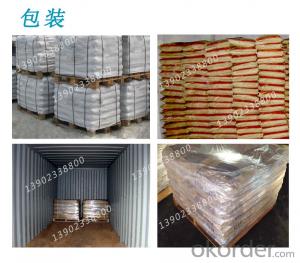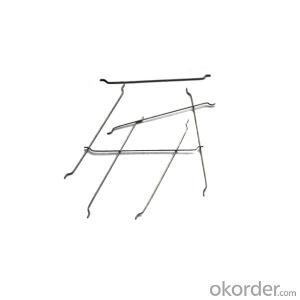Melt Extract Stainless Steel Fiber Reinforced Bending CNBM China
- Loading Port:
- Tianjin
- Payment Terms:
- TT OR LC
- Min Order Qty:
- 1000 kg
- Supply Capability:
- 250000 kg/month
OKorder Service Pledge
OKorder Financial Service
You Might Also Like
Quick Details
Dimensions: steel wire
Grade: steel wire
Application: for concrete reinorcement
Shape: clear and bright
material: steel wire
type: wavy steel fiber
shape: corrugated flat fiber
usage: concrete reinforcement
appearance: clear and bright
Place of Origin: Shandong, China (Mainland)
Product features
steel fiber are for concrete construction, greatly improves concrete bonding and tensile strength .
concrete steel fiber is specially designed to enhance concrete in it`s hardened state ,the uniform distribution of steel fibers throughout the concrete greatly improves concrete bonding and tensile strength ,additionally it provides exceptional load stability and durability .
as reliable and efficient concrete reinforcement material ,it is widely uesd in buildings ,bridges ,thin roof engineering ,highway etc.
Specifications
Diameter :0.5-1.2mm
Tensile strength :≥1100Mpa
Length :20-60mm
properties :excellent tensile ,high tenacity ,against cracking and fatigue
type :any type we can produce according to your request
Picture

steel fiber concrete reinforced
FAQ
we can produce any type steel fiber and of course we can make production according to your requirement
we have specilize in this field for almost 10 years ,with good quality and competitive price
- Q: Can melt extract stainless steel fiber be used in sports field pavements?
- Yes, melt extract stainless steel fiber can be used in sports field pavements. Its high tensile strength and corrosion resistance make it suitable for withstanding the heavy foot traffic and weather conditions typically found in sports fields. Additionally, its durability helps enhance the longevity and performance of the pavement, making it a viable option for such applications.
- Q: Can melt extract stainless steel fiber be used in ultra-high-performance concrete (UHPC)?
- Yes, melt extract stainless steel fiber can be used in ultra-high-performance concrete (UHPC). UHPC is known for its exceptional strength, durability, and enhanced performance characteristics, and the addition of stainless steel fibers can further enhance these properties. Melt extract stainless steel fibers are specifically designed to improve the tensile strength, ductility, and resistance to cracking of concrete. They also provide excellent corrosion resistance, which is crucial for long-term durability in aggressive environments. Additionally, the small diameter and high aspect ratio of these fibers allow for improved dispersion and bonding within the concrete matrix, resulting in enhanced crack resistance and overall performance. Therefore, the use of melt extract stainless steel fibers in UHPC can significantly improve its mechanical properties and longevity, making it a suitable choice for demanding applications such as high-rise buildings, infrastructure projects, and precast elements.
- Q: Can melt extract stainless steel fiber be used in precast concrete cladding panels?
- Yes, melt extract stainless steel fiber can be used in precast concrete cladding panels. Stainless steel fibers are often added to concrete mixtures to improve the overall strength, durability, and resistance to cracking. The use of stainless steel fibers in precast concrete cladding panels can enhance their structural integrity and increase resistance to impact and weathering. Additionally, the addition of stainless steel fibers can improve the panel's resistance to corrosion, making it suitable for use in exterior applications. Overall, melt extract stainless steel fiber can be a beneficial addition to precast concrete cladding panels, enhancing their performance and longevity.
- Q: What is the cost-effectiveness of using melt extract stainless steel fiber in concrete?
- The cost-effectiveness of using melt extract stainless steel fiber in concrete can be quite high. While the initial cost of incorporating stainless steel fibers may be higher compared to traditional reinforcement methods, the long-term benefits outweigh the expenses. Stainless steel fibers improve the durability, strength, and crack resistance of concrete structures, reducing the need for frequent repairs and maintenance. This results in cost savings over the lifespan of the structure, making it a cost-effective choice in the long run. Additionally, the use of stainless steel fibers can enhance the overall performance and lifespan of the concrete, making it a reliable and efficient construction material.
- Q: Can melt extract stainless steel fiber be used in self-compacting concrete?
- Yes, melt extract stainless steel fiber can be used in self-compacting concrete. The addition of stainless steel fibers helps enhance the strength, durability, and crack resistance of the concrete, making it suitable for self-compacting applications.
- Q: Can melt extract stainless steel fiber be used in earthquake-resistant concrete structures?
- Certainly, earthquake-resistant concrete structures can utilize melt extract stainless steel fiber. Renowned for their exceptional ductility and high tensile strength, stainless steel fibers are an ideal choice for bolstering the toughness and durability of concrete. The inclusion of these fibers in concrete enhances its ability to withstand cracking, shrinkage, and spalling during seismic events. The utilization of stainless steel fibers in earthquake-resistant concrete structures plays a crucial role in mitigating the adverse effects of earthquakes. Acting as reinforcement, these fibers augment the concrete's strength and hinder the propagation of cracks. This reinforcement fortifies the overall structural integrity of the concrete, rendering it more resistant to the dynamic forces unleashed by earthquakes. Furthermore, melt extract stainless steel fibers possess a high melting point, corrosion resistance, and exceptional thermal stability. These attributes render them suitable for long-term implementation in hostile environments, such as earthquake-prone regions. These fibers remain intact over time, ensuring the concrete structure's long-lasting durability and efficacy. Additionally, melt extract stainless steel fibers have undergone rigorous testing and have been proven to enhance the seismic performance of concrete structures. They conform to various international standards, such as ASTM and ACI, guaranteeing their quality and reliability. These fibers have successfully been employed in a diverse array of earthquake-resistant applications, including bridges, tunnels, high-rise buildings, and industrial structures. In conclusion, melt extract stainless steel fiber can indeed be employed in earthquake-resistant concrete structures. Its exceptional tensile strength, ductility, and resistance to cracking make it an outstanding reinforcement material for fortifying the durability and seismic performance of concrete. By incorporating stainless steel fibers into concrete, engineers can effectively bolster the resistance of structures to seismic forces, ensuring the safety and longevity of infrastructure in earthquake-prone regions.
- Q: How does melt extract stainless steel fiber improve the durability of nuclear power plant concrete?
- Enhancing the durability of nuclear power plant concrete is an essential function of melt extract stainless steel fiber. These fibers are specifically designed to withstand the harsh conditions present in nuclear power plants, including exposure to radiation, extreme temperatures, and high levels of moisture. One way in which melt extract stainless steel fiber improves the durability of nuclear power plant concrete is by reinforcing its structural integrity. By adding these fibers, the tensile strength of the concrete is increased, making it more resistant to cracking and spalling. This is particularly important in nuclear power plants, as any damage to the concrete can have severe consequences for the facility's safety and operation. Additionally, the unique properties of stainless steel fibers make them highly resistant to corrosion. Nuclear power plants are exposed to corrosive elements, such as chemicals and moisture, which can gradually deteriorate the concrete. Incorporating melt extract stainless steel fiber into the concrete mix significantly reduces the risk of corrosion, ensuring the long-term durability of the structure. Another advantage of melt extract stainless steel fiber is its ability to enhance the concrete's resistance to thermal stress. As nuclear power plants operate at high temperatures, the concrete structures must be able to withstand expansion and contraction. By adding these fibers, thermal stresses are distributed more evenly, preventing cracks and maintaining the overall integrity of the concrete. Furthermore, melt extract stainless steel fiber effectively mitigates the effects of radiation on nuclear power plant concrete. The fibers act as a radiation shield, absorbing and dispersing harmful radiation that can penetrate the concrete. This not only protects the structural integrity of the concrete but also maintains the safety of plant personnel and the surrounding environment. In conclusion, melt extract stainless steel fiber is crucial in improving the durability of nuclear power plant concrete. By reinforcing structural integrity, resisting corrosion, enhancing resistance to thermal stress, and mitigating the effects of radiation, these fibers ensure the long-term performance and safety of the concrete structures in nuclear power plants.
- Q: How does melt extract stainless steel fiber contribute to the fatigue behavior of concrete?
- Melt extract stainless steel fiber plays a significant role in enhancing the fatigue behavior of concrete. The addition of these fibers in the concrete mix improves its resistance to cracking and increases its durability, particularly under cyclic loading conditions. One of the main ways in which melt extract stainless steel fiber contributes to the fatigue behavior of concrete is by reducing the propagation of microcracks. As concrete is subjected to repeated loading and unloading cycles, microcracks begin to form and propagate, leading to eventual failure. However, the presence of stainless steel fibers acts as a reinforcement, effectively bridging these microcracks and preventing their further propagation. This improves the overall fatigue resistance of the concrete and extends its service life. Moreover, melt extract stainless steel fibers also enhance the tensile strength and ductility of concrete. Concrete is known for its low tensile strength, and the inclusion of fibers helps to overcome this weakness. The fibers distribute the applied load more evenly throughout the concrete matrix, reducing stress concentrations and enhancing its ability to withstand cyclic loading. This, in turn, leads to improved fatigue behavior. Additionally, the use of melt extract stainless steel fibers in concrete can also improve its resistance to corrosion. Stainless steel is inherently resistant to corrosion, and when incorporated into the concrete mix, it acts as a protective barrier against the ingress of aggressive substances such as chlorides and sulfates. This helps to prevent corrosion of the reinforcing steel within the concrete, which can weaken its structural integrity and lead to premature failure. In conclusion, melt extract stainless steel fiber greatly contributes to the fatigue behavior of concrete by reducing microcrack propagation, increasing tensile strength and ductility, and improving resistance to corrosion. These benefits enhance the overall durability and lifespan of concrete structures, making them more reliable and cost-effective in the long run.
- Q: How does melt extract stainless steel fiber improve the abrasion resistance of concrete?
- The abrasion resistance of concrete can be improved by the addition of melt extract stainless steel fiber through various mechanisms. Firstly, incorporating stainless steel fibers into the concrete matrix enhances its tensile strength, thereby making it more resistant to cracking and spalling caused by abrasive forces. This is particularly crucial in areas with high traffic or in industrial settings where the concrete undergoes significant wear and tear. Secondly, the stainless steel fibers play a reinforcing role within the concrete, forming a three-dimensional network that enhances the overall durability and toughness of the material. Consequently, the concrete becomes less susceptible to abrasive damage and can withstand higher levels of mechanical stress. Furthermore, the unique attributes of stainless steel, such as its resistance to corrosion and high melting point, make it an ideal material for enhancing abrasion resistance. Unlike conventional steel fibers, stainless steel fibers do not rust or corrode, even in harsh environments, ensuring the long-term durability of the concrete structure. Moreover, the small diameter and high aspect ratio of melt extract stainless steel fibers further contribute to the improved abrasion resistance. These fibers are typically very fine and uniformly dispersed throughout the concrete, creating a dense network that effectively withstands abrasive forces and prevents crack formation. Overall, the addition of melt extract stainless steel fiber to concrete enhances its abrasion resistance by increasing tensile strength, providing reinforcement, offering corrosion resistance, and optimizing the microstructure of the material. This results in a concrete surface that is more durable and long-lasting, capable of withstanding heavy traffic and abrasive conditions.
- Q: Does melt extract stainless steel fiber affect the electrical conductivity of concrete?
- Yes, melt extract stainless steel fiber does affect the electrical conductivity of concrete. The addition of stainless steel fibers increases the electrical conductivity of concrete due to the conductive nature of stainless steel. This can be advantageous in applications where electrical conductivity is desired, such as in grounding systems or electromagnetic shielding.
Send your message to us
Melt Extract Stainless Steel Fiber Reinforced Bending CNBM China
- Loading Port:
- Tianjin
- Payment Terms:
- TT OR LC
- Min Order Qty:
- 1000 kg
- Supply Capability:
- 250000 kg/month
OKorder Service Pledge
OKorder Financial Service
Similar products
Hot products
Hot Searches
Related keywords
